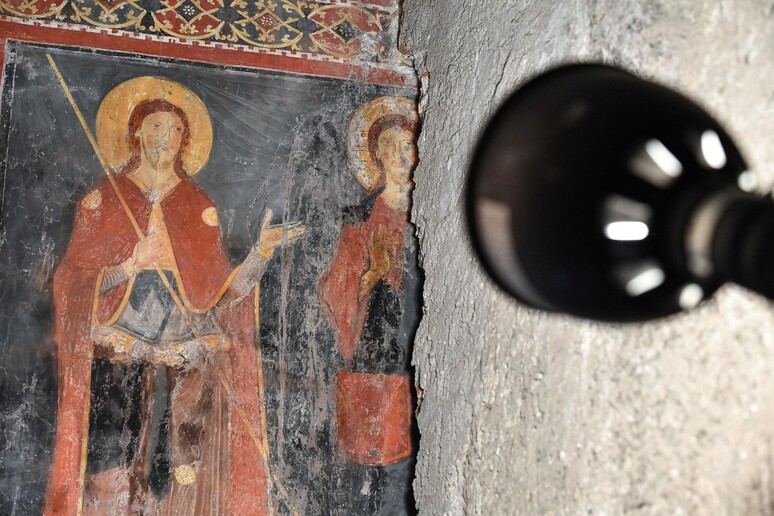The fresco shows a large purple
mantle over the skimpy clothes of the pilgrim, a hand raised
almost as if to introduce the majesty of Christ, who is blessing
the believers next to him.
Hidden by a wall for almost 900 years, the medieval fresco
was found in an interspace of the Sant'Alessio church on the
Aventine hill and in a surprisingly good state of conservation
with luminescent colours.
"This is absolutely an exceptional find," ANSA was told in an
exclusive interview with the woman who made the discovery, the
art historian Claudia Viggiani. "Especially for the very rare
iconography, which shows two figures that can be recognised in
the part of the painting at the moment visible, most likely
Saint Alexis and Christ the Pilgrim."
The discovery, which ANSA was able to document with photos
and video, is the result of years-long research and has
something of a detective story behind it.
"Everything began during research into archives," Viggiani
said, who alternates working as a researcher and as a cultural
consultant for mayors and ministries.
Sparking her curiosity was a letter written in 1965
superintendent's office for Lazio monuments, in which mention is
made of "a fresco in excellent condition" found by chance during
the works for the consolidation of a bellower.
But which church, she asked herself.
The document, Viggiani said, did not give the name.
Faced with that marvel of colours, the unknown official in
the 1960s seems to have closed the door and left the painting to
its centuries-long oblivion.
"It took a while but in the end I found it," the scholar
smiled.
Determination was decisive in this case.
A few months ago the work was secured by restorer Susanna
Sarmati with a project implemented thanks to the Rome special
superintendent's office under Francesco Prosperetti with
Mariella Nuzzo and Carlo Testa.
The small door behind Sant'Alessio that hides the interspace
is however inaccessible for security reasons.
However, crossing through the door with the permission of Don
Bruno, the parson of Sant'Alessio, one meets with an explosion
of color, an intense black background and the cinnabar of the
mantle.
There is also the penetrating gaze of Christ and the priestly
serenity of the saint imitating him and resembling him a bit, as
if he wanted to present himself as a 'human' copy of the
Messiah.
Dating back to the mid-12th century, the painting has a
polychrome frame that restorer Sarmati said was of "exceptional
sophistication" and that it is difficult to "find ones that are
so complete".
She pointed at the original brushstrokes on the wall, which
can still be distinguished.
Though other medieval frescoes exist in Rome, "their state of
conservation despite restoration, is mediocre. This one,
however," she said, "which was never touched is almost perfect."
In the original church, Viggiani said, the painting was in an
important position due in part to the fame that St Alexis had in
that period.
It was precisely for the devotional respect for the saint
that was said to have been the son of Roman senator Euphemian
and who in some way seems to have been the connection between
pagan Rome and medieval Rome that is thought to be the reason
for the incredible state of conservation.
"Whoever renovated the church in the centuries that followed,
walling in the counter-facade was careful to protect the
fresco," she said.
A small part of it with St Alexis's face was probably left
visible to churchgoers through a small crack open in the inside
of the nave.
The painting now measures 90 centimeters long by over 4 high
and another section that is at least as large is still hidden by
the wall.
Viggiani is determined to bring it, too, to light.
"We owe this to the Romans," she said, "and there are more
surprises awaiting us."
ALL RIGHTS RESERVED © Copyright ANSA











